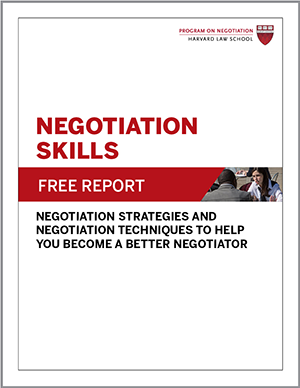
In their revolutionary book Getting to Yes: Negotiating Agreement Without Giving In (Penguin, 3rd edition, 2011), Roger Fisher, William Ury, and Bruce Patton introduced the world to the possibilities of mutual-gains negotiation, or integrative negotiation. The authors of Getting to Yes explained that negotiators don’t have to choose between either waging a strictly competitive, win-lose negotiation battle or caving in to avoid conflict.
Rather, they argued, bargainers can and should look for negotiation strategies that can help both sides get more of what they want. By listening closely to each other, treating each other fairly, and jointly exploring options to increase value, negotiators can find ways of getting to yes that reduce the need to rely on hard-bargaining tactics and unnecessary concessions.
1. Separate the people from the problem.
In negotiation, it’s easy to forget that our counterparts have feelings, opinions, values, and unique backgrounds that contribute to what they do and say during talks. When misunderstandings and conflict arise in negotiation, we need to deal with the “people problem” directly rather than trying to gloss over it with concessions, according to the authors of Getting to Yes. Strive to imagine the situation from their counterpart’s viewpoint. If someone is refusing to back down from a hardline position, ask her how she thinks things are going. Exploring each side’s perceptions openly and avoiding the tendency to blame are key negotiation skills.
2. Focus on interests, not positions.
We tend to begin our negotiation by stating our positions. A homeowner might say to a developer, for instance, “I won’t allow you to develop this property.” When we stake out firm positions, we set ourselves up for impasse. In our goal of getting to yes, we need to draw out the interests underlying our counterpart’s positions by asking questions, such as, “Why is this property important to you?” By identifying what interests are motivating the other party, and sharing your own interests, you can open up opportunities to explore tradeoffs across issues and increase your odds of getting to yes.
3. Learn to manage emotions.
Be sure that you and your counterpart have ample opportunities to express and discuss any strong emotions related to your negotiation. Allowing one another to speak your mind will benefit both sides. “Freed from the burden of unexpressed emotions,” write the authors in Getting to Yes, “people will become more likely to work on the problem.” They tell the story of a labor-management group that “adopted the rule that only one person could get angry at a time,” a tactic that prevented arguments from escalating. When you know that you will have your turn to express how you’re feeling, it will be easier for you to listen when your counterpart has his turn.
4. Express appreciation.
Throughout his career at the vanguard of integrative negotiation, Fisher stressed the importance of expressing appreciation as a means of breaking through impasse. “No one likes to feel unappreciated, and this is particularly true in a negotiation,” Fisher once told Program on Negotiation managing director Susan Hackley. In their book Beyond Reason (Penguin, 2005), Fisher and Dan Shapiro advised negotiators to express appreciation by working to understand the other’s perspective, seeking merit in that perspective, and communicating understanding through words and actions—all critical negotiation skills.
5. Put a positive spin on your message.
Communicating in a positive way is a much more effective means of getting to yes than blaming and criticizing. Instead of speaking on behalf of your group, speak only for yourself. For example, saying “Everyone on the team feels that you’re not pulling your weight” to an employee is likely to distract her from your message, as she will wonder who has been talking about her and what they’ve said. Instead, talk about what you personally have observed and express your concern: “Your recent work has fallen short of your high performance levels. Is there anything going on that is keeping you from doing your best?”
6. Escape the cycle of action and reaction.
In Getting to Yes, Fisher, Ury, and Patton caution us to avoid the common negotiation trap of action and reaction: “If the other side announces a firm position, you may be tempted to criticize and reject it. If they criticize your proposal, you may be tempted to defend it and dig yourself in . . . if they push you hard, you will tend to push back.” To head off this vicious cycle, Fisher, Ury, and Patton introduce a negotiation skill they call negotiation jujitsu, which involves avoiding escalation by refusing to react. Instead, they advise us to channel our resistance into more productive negotiation strategies, such as “exploring interests, inventing options for mutual gain, and searching for independent standards.”
What methods have helped in you getting to yes?






Based on your summary, you’ve covered many of the key principles from “Getting to Yes” by Fisher, Ury, and Patton. However, there are a couple of additional core concepts from the book that are worth mentioning:
7. Invent Options for Mutual Gain: This principle emphasizes the importance of creativity in negotiations. Rather than sticking to a fixed position, the idea is to brainstorm a wide range of possibilities that could satisfy both parties’ interests. This can lead to solutions that weren’t initially apparent and can provide win-win outcomes.
8. Insist on Using Objective Criteria: In negotiations, it’s beneficial to base decisions on objective, independent standards rather than on power, pressure, or subjective opinions. This could include market value, legal precedent, expert opinion, or other forms of external, objective data. Using such criteria can make negotiations more fair and amicable.
The thing that has really helped my negotiation skill has been to ask, “Why would my counterpart accept this proposal?”
Not only has this helped to achieve more objectives, but it has also benefitted my empathy towards the other party’s situation.
Thanks for all your good work–and sharing it so openly. I’m not sure if there’s a name for this, but I use a technique that seems very helpful when I’m helping groups negotiate agreements–that is, starting with testing simple agreements and then moving progressively toward the more challenging agreements. That might be starting with “So I’m hearing that we all believe that we need to resolve this issue. Is that right?” I find that it’s helpful because it points out that we do agree on some things and we’re making progress and moving forward toward resolution. It’s also helpful because it helps me understand where the point of divergence and convergence is, so I can focus the negotiation more clearly.
Thank you for sharing this summary. It has answered my questions. One of my questions was that why I was 100% successful in some negotiation, and I was not successful in others? My perception was that the problems come from counterparts. However, after reading this summery, I understand that the problem is about me. I have learned that I am the Hard Negotiator. So, when I am dealing with Soft Negotiator, I am the winner. Otherwise, when I am dealing with Hard Negotiator, I am not able to reach to my goals. In addition, I have learned Negotiation is the skill that I should practice it to improve that. Finally, this learning process taught me that the Principled Negotiator have practiced the skills and prepare for the meeting before that.
Your website states “Roger Fisher, William Ury, and Bruce Patton introduced the world to the possibilities of mutual-gains negotiation, or integrative negotiation.”
Back in 1965 Walton and McKersie’s pioneering study Behavioral Theory of Labor Negotiations clearly articulated what they called “integrative bargaining” with tactics such as mutual agreement on the problem, mutual exchange of information, mutual trust and search for the best alternative. Sound familiar? Getting to Yes did not acknowledge Walton and McKersie’s book although every book I have every read on collective bargaining does. Getting to Yes uses the phrase “be soft on the people and hard on the problem.” As an example, Walton and McKersie quoted M. Gandhi: be hard on the antagonism and soft on the antagonist.
Thank you for teaching required skills to negotiate in a difficult situatio.
Thank you for a good summary reminder of the key interaction approaches, given in the book, ” Getting to Yes”. It is a wonderfully useful book which every intelligent human being should read in his/her life time…and practise its mentioned golden principles of negotiation…
It has been extremely useful visit of your website and i have learned how to be a successful negotiator in a critical situation being an administrator in civil administration